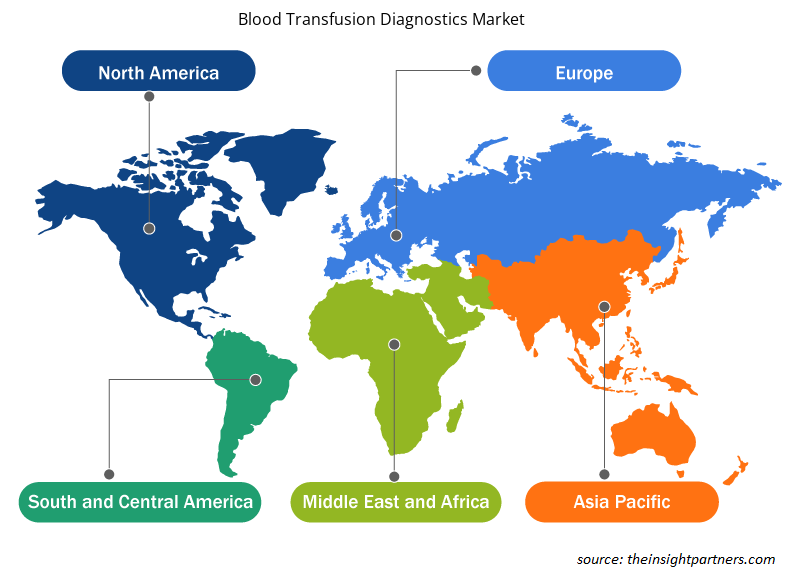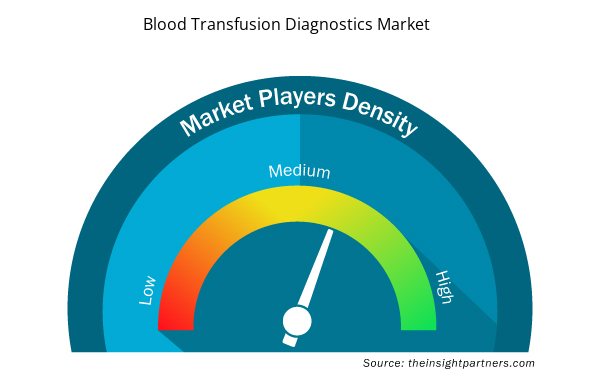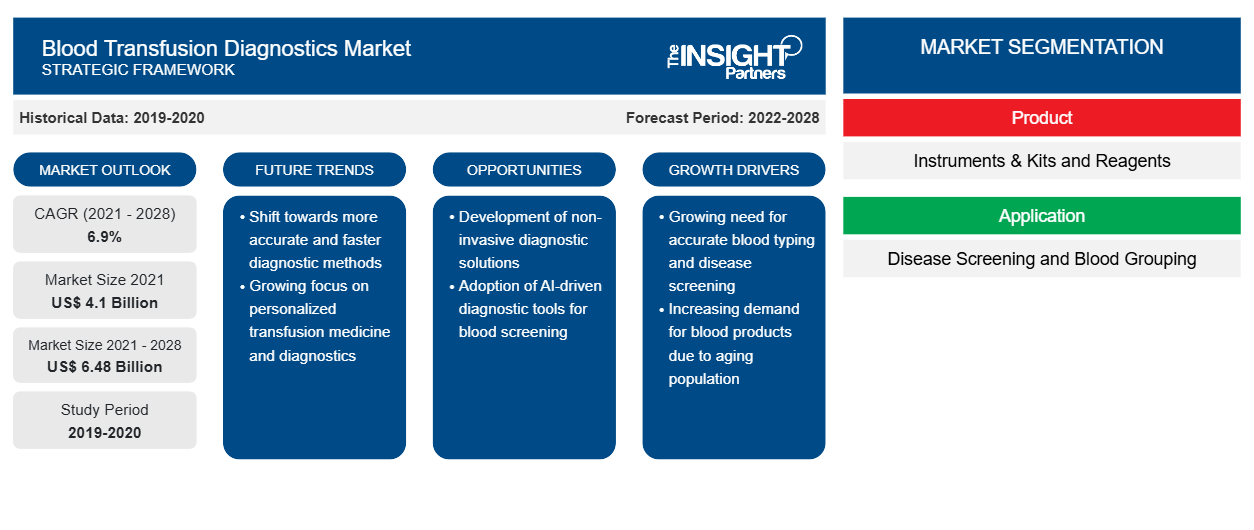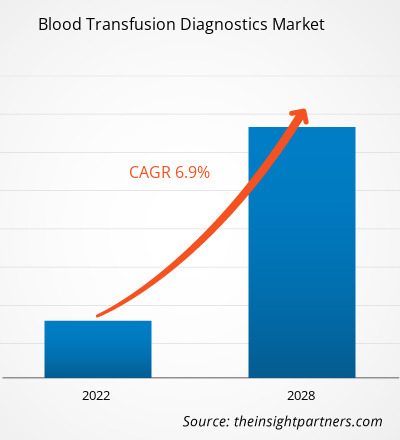[研究报告] 输血诊断市场预计将从 2021 年的 40.9693 亿美元增长到 2028 年的 64.8375 亿美元。预计 2022 年至 2028 年的复合年增长率为 6.9%。
输血诊断是在将血液输给患者之前进行的检测。输血是一种常见的程序,其中捐献的血液或其成分通过静脉注射途径输入患者体内。每单位血液都必须进行血型鉴定,即确定血型和血液筛查,包括疾病检测测试,以避免副作用或感染传播。
该报告对全球输血诊断市场提供了见解和深入分析,强调了各种参数,包括市场趋势、技术进步、市场动态和全球主要市场参与者的竞争格局分析。它还包括COVID-19大流行对所有地区市场的影响。COVID-19大流行对全球输血诊断市场的增长产生了负面影响。由于政府实施的严格限制导致外科手术数量减少,其收入大幅下降。这些服务主要用于失血量大的手术,例如骨科和心脏手术。由于手术数量减少,输血需求也减少了。例如:根据美国医学会发布的数据,估计由于COVID-19大流行,美国执行的外科手术总数减少了48%。然而,在大流行限制正常化后,外科手术量恢复到正常水平。
定制此报告以满足您的需求
您可以免费定制任何报告,包括本报告的部分内容、国家级分析、Excel 数据包,以及为初创企业和大学提供优惠和折扣
- 获取此报告的关键市场趋势。这个免费样品将包括数据分析,从市场趋势到估计和预测。
基于地理位置的洞察
根据地域划分,全球输血诊断市场分为北美(美国、加拿大和墨西哥)、欧洲(法国、德国、英国、西班牙、意大利和欧洲其他地区)、亚太地区(中国、印度、日本、澳大利亚、韩国和亚太地区其他地区)、中东和非洲(沙特阿拉伯、阿联酋、南非和中东和非洲其他地区)以及南美洲和中美洲(巴西、阿根廷和南美洲和中美洲其他地区)。
市场洞察
器官移植手术增多导致输血需求增加
器官移植是在器官衰竭的情况下进行的外科手术。通常,器官移植手术针对心脏、肝脏、肾脏和其他各种器官,因为慢性疾病病例不断增加,例如慢性肾病 (CKD)、多囊肾病、囊性纤维化和先天性心脏病,这些疾病都需要移植。这些手术通常需要几个小时,而且会大量失血,需要输血。例如,根据器官共享联合网络 (UNOS) 的数据,美国进行的器官移植 数量持续增加,2021 年进行了超过 41,000 例移植。同样,根据世界移植登记处的数据,西班牙占 2019 年欧洲所有器官捐赠的 20%,占全球的 6%。澳大利亚的器官捐赠率最近有所提高,2019 年上升至每百万人口 21.8 名捐赠者。
同样,加拿大每百万人口有 22.2 名器官捐献者,并且还在稳步提高,这部分归功于“器官捐献医生”这一数字——负责器官捐献的重症监护医生。根据世界移植登记处的数据,2019 年,中国有 5,818 名器官捐献者,即每百万人口 4.1 名器官捐献者,印度有 715 名器官捐献者,即每百万人口 0.5 名器官捐献者。另一方面,俄罗斯的器官捐献者比例略高,为每百万人口 5.1 名器官捐献者。公私合作伙伴关系与移植协调员合作,为需要不断输血的器官移植的改善做出了重大贡献。发展中国家和发达国家的器官移植手术都有所增加。例如,印度和新加坡等发展中国家正在成为亚太地区的医疗旅游 目的地。各国在提供更好、更先进的医疗服务方面正在取得进步。器官移植需求的增加是推动全球输血诊断需求的关键因素之一。
基于产品的洞察
根据产品,全球输血诊断市场分为仪器和试剂盒以及试剂。2021 年,仪器和试剂盒部分占据了更大的市场份额。预计同一部分将在 2022 年至 2028 年期间在市场上实现更高的复合年增长率。
基于应用的洞察
根据应用,全球输血诊断市场分为疾病筛查和血型鉴定。疾病筛查部分在 2021 年占据了更大的市场份额,预计在预测期内将实现更高的复合年增长率。
输血诊断市场区域洞察
Insight Partners 的分析师已详尽解释了预测期内输血诊断市场的区域趋势和影响因素。本节还讨论了输血诊断市场在北美、欧洲、亚太地区、中东和非洲以及南美和中美的细分市场和地理位置。

- 获取输血诊断市场的区域特定数据
输血诊断市场报告范围
| 报告属性 | 细节 |
|---|---|
| 2021 年市场规模 | 41亿美元 |
| 2028 年市场规模 | 64.8亿美元 |
| 全球复合年增长率(2021 - 2028) | 6.9% |
| 史料 | 2019-2020 |
| 预测期 | 2022-2028 |
| 涵盖的领域 | 按产品
|
| 覆盖地区和国家 | 北美
|
| 市场领导者和主要公司简介 |
|
输血诊断市场参与者密度:了解其对业务动态的影响
输血诊断市场正在快速增长,这得益于终端用户需求的不断增长,而这些需求又源于消费者偏好的不断变化、技术进步以及对产品优势的认识不断提高等因素。随着需求的增加,企业正在扩大其产品范围,进行创新以满足消费者的需求,并利用新兴趋势,从而进一步推动市场增长。
市场参与者密度是指在特定市场或行业内运营的企业或公司的分布情况。它表明在给定市场空间中,相对于其规模或总市场价值,有多少竞争对手(市场参与者)存在。
在输血诊断市场运营的主要公司有:
- 格里福斯公司
- F. 霍夫曼-罗氏有限公司
- Immucor 公司
- Bio-Rad 实验室公司
- 雅培
免责声明:上面列出的公司没有按照任何特定顺序排列。

- 了解输血诊断市场的主要参与者概况
基于最终用户的洞察
根据最终用户,全球输血诊断市场分为血库、医院、诊断实验室和血浆分离 公司。血库部门在 2021 年占据了最大的市场份额。预计同一部门将在 2022 年至 2028 年期间实现市场最高复合年增长率。
全球输血诊断市场参与者采取有机战略,包括产品发布和扩张,以扩大其全球足迹和产品组合并满足不断增长的需求。市场的主要参与者是 Grifols, SA;F. Hoffmann-La Roche Ltd;Immucor, Inc.;Bio-Rad Laboratories, Inc.;Abbott;Thermo Fisher Scientific Inc.;Ortho Clinical Diagnostics;DiaSorin SpA;Quotient Limited;和 BAG Diagnostics GmbH。
- 历史分析(2 年)、基准年、预测(7 年)及复合年增长率
- PEST 和 SWOT 分析
- 市场规模价值/数量 - 全球、区域、国家
- 行业和竞争格局
- Excel 数据集


- Resistance Bands Market
- Sports Technology Market
- Quantitative Structure-Activity Relationship (QSAR) Market
- Digital Pathology Market
- Animal Genetics Market
- Data Annotation Tools Market
- Fill Finish Manufacturing Market
- Sweet Potato Market
- Trade Promotion Management Software Market
- Public Key Infrastructure Market

Report Coverage
Revenue forecast, Company Analysis, Industry landscape, Growth factors, and Trends

Segment Covered
This text is related
to segments covered.

Regional Scope
North America, Europe, Asia Pacific, Middle East & Africa, South & Central America

Country Scope
This text is related
to country scope.
常见问题
Global blood transfusion diagnostics market is segmented by region into North America, Europe, Asia Pacific, Middle East & Africa, and South & Central America. In North America, the U.S. is the largest market for blood transfusion diagnostics market. The growth of the market in North America is expected due to the factors such as increasing surgical procedures for chronic health conditions, rising collaborative agreements between key players, and growing progress in the health system for blood transfusion diagnostics. However, the improvement in blood transfusion management, increasing prevalence of sepsis and thalassemia, and the introduction of advanced molecular platforms are the key factor responsible for the Asia-Pacific regional growth for blood transfusion diagnostics accounting fastest growth of the region during the coming years.
Grifols, S.A.; F. Hoffmann-La Roche Ltd; DiaSorin S.p.A.; BAG Diagnostics GmbH; Abbott; Bio-Rad Laboratories, Inc.; Immucor, Inc.; Thermo Fisher Scientific Inc.; Ortho Clinical Diagnostics; and Quotient Limited are among the leading companies operating in the blood transfusion diagnostics market.
The blood banks segment dominated the global blood transfusion diagnostics market and accounted for the largest market share of 40.23% in 2021.
Based on application, disease screening segment took the forefront lead in the worldwide market by accounting largest share in 2021 and is expected to continue to do so till the forecast period.
Based on products, instruments and kits segment took the forefront lead in the worldwide market by accounting largest share in 2021 and is expected to continue to do so till the forecast period.
Blood transfusion diagnostics refers to tests performed on blood and blood components before they are transfused to patients. A blood transfusion is a common procedure in which donated blood or blood components are transfused into the patient's body through an intravenous line (IV). Each unit of blood must undergo blood typing, which refers to the identification of blood type and blood screening, including disease detection tests to avoid side effects or transmission of infection. Blood screening before transfusion is performed through instruments, kits, and reagents to identify various diseases, such as HIV, hepatitis B, hepatitis C, Zika, and different viruses and infections.
Rapid increase in chronic diseases and increasing need for blood transfusion due to rise in organ transplants surgeries are the most significant factors responsible for the overall market growth.
Trends and growth analysis reports related to Life Sciences : READ MORE..
The List of Companies - Blood Transfusion Diagnostics Market
- Grifols, S.A.
- F. Hoffmann-La Roche Ltd
- Immucor, Inc.
- Bio-Rad Laboratories Inc.
- Abbott
- Thermo Fisher Scientific Inc.
- Ortho Clinical Diagnostics
- DiaSorin S.p.A.
- Quotient Limited
- BAG Diagnostics GmbH
The Insight Partners performs research in 4 major stages: Data Collection & Secondary Research, Primary Research, Data Analysis and Data Triangulation & Final Review.
- Data Collection and Secondary Research:
As a market research and consulting firm operating from a decade, we have published and advised several client across the globe. First step for any study will start with an assessment of currently available data and insights from existing reports. Further, historical and current market information is collected from Investor Presentations, Annual Reports, SEC Filings, etc., and other information related to company’s performance and market positioning are gathered from Paid Databases (Factiva, Hoovers, and Reuters) and various other publications available in public domain.
Several associations trade associates, technical forums, institutes, societies and organization are accessed to gain technical as well as market related insights through their publications such as research papers, blogs and press releases related to the studies are referred to get cues about the market. Further, white papers, journals, magazines, and other news articles published in last 3 years are scrutinized and analyzed to understand the current market trends.
- Primary Research:
The primarily interview analysis comprise of data obtained from industry participants interview and answers to survey questions gathered by in-house primary team.
For primary research, interviews are conducted with industry experts/CEOs/Marketing Managers/VPs/Subject Matter Experts from both demand and supply side to get a 360-degree view of the market. The primary team conducts several interviews based on the complexity of the markets to understand the various market trends and dynamics which makes research more credible and precise.
A typical research interview fulfils the following functions:
- Provides first-hand information on the market size, market trends, growth trends, competitive landscape, and outlook
- Validates and strengthens in-house secondary research findings
- Develops the analysis team’s expertise and market understanding
Primary research involves email interactions and telephone interviews for each market, category, segment, and sub-segment across geographies. The participants who typically take part in such a process include, but are not limited to:
- Industry participants: VPs, business development managers, market intelligence managers and national sales managers
- Outside experts: Valuation experts, research analysts and key opinion leaders specializing in the electronics and semiconductor industry.
Below is the breakup of our primary respondents by company, designation, and region:

Once we receive the confirmation from primary research sources or primary respondents, we finalize the base year market estimation and forecast the data as per the macroeconomic and microeconomic factors assessed during data collection.
- Data Analysis:
Once data is validated through both secondary as well as primary respondents, we finalize the market estimations by hypothesis formulation and factor analysis at regional and country level.
- Macro-Economic Factor Analysis:
We analyse macroeconomic indicators such the gross domestic product (GDP), increase in the demand for goods and services across industries, technological advancement, regional economic growth, governmental policies, the influence of COVID-19, PEST analysis, and other aspects. This analysis aids in setting benchmarks for various nations/regions and approximating market splits. Additionally, the general trend of the aforementioned components aid in determining the market's development possibilities.
- Country Level Data:
Various factors that are especially aligned to the country are taken into account to determine the market size for a certain area and country, including the presence of vendors, such as headquarters and offices, the country's GDP, demand patterns, and industry growth. To comprehend the market dynamics for the nation, a number of growth variables, inhibitors, application areas, and current market trends are researched. The aforementioned elements aid in determining the country's overall market's growth potential.
- Company Profile:
The “Table of Contents” is formulated by listing and analyzing more than 25 - 30 companies operating in the market ecosystem across geographies. However, we profile only 10 companies as a standard practice in our syndicate reports. These 10 companies comprise leading, emerging, and regional players. Nonetheless, our analysis is not restricted to the 10 listed companies, we also analyze other companies present in the market to develop a holistic view and understand the prevailing trends. The “Company Profiles” section in the report covers key facts, business description, products & services, financial information, SWOT analysis, and key developments. The financial information presented is extracted from the annual reports and official documents of the publicly listed companies. Upon collecting the information for the sections of respective companies, we verify them via various primary sources and then compile the data in respective company profiles. The company level information helps us in deriving the base number as well as in forecasting the market size.
- Developing Base Number:
Aggregation of sales statistics (2020-2022) and macro-economic factor, and other secondary and primary research insights are utilized to arrive at base number and related market shares for 2022. The data gaps are identified in this step and relevant market data is analyzed, collected from paid primary interviews or databases. On finalizing the base year market size, forecasts are developed on the basis of macro-economic, industry and market growth factors and company level analysis.
- Data Triangulation and Final Review:
The market findings and base year market size calculations are validated from supply as well as demand side. Demand side validations are based on macro-economic factor analysis and benchmarks for respective regions and countries. In case of supply side validations, revenues of major companies are estimated (in case not available) based on industry benchmark, approximate number of employees, product portfolio, and primary interviews revenues are gathered. Further revenue from target product/service segment is assessed to avoid overshooting of market statistics. In case of heavy deviations between supply and demand side values, all thes steps are repeated to achieve synchronization.
We follow an iterative model, wherein we share our research findings with Subject Matter Experts (SME’s) and Key Opinion Leaders (KOLs) until consensus view of the market is not formulated – this model negates any drastic deviation in the opinions of experts. Only validated and universally acceptable research findings are quoted in our reports.
We have important check points that we use to validate our research findings – which we call – data triangulation, where we validate the information, we generate from secondary sources with primary interviews and then we re-validate with our internal data bases and Subject matter experts. This comprehensive model enables us to deliver high quality, reliable data in shortest possible time.


 获取此报告的免费样本
获取此报告的免费样本